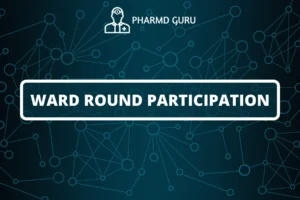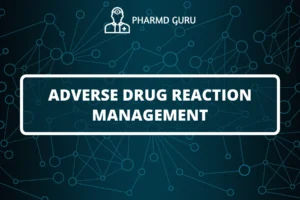Drug utilization evaluation and review (DUR) is a systematic process used to assess and optimize the use of medications. It involves analyzing prescribing patterns, medication adherence, and patient outcomes to ensure safe, effective, and cost-efficient drug therapy. In this article, we will explore the importance of DUR, its key components, and the role of clinical pharmacists in conducting DUR to enhance medication safety and efficacy.
SCROLL DOWN TO THE BOTTOM OF THE PAGE FOR ACTUAL NOTES
TABLE OF CONTENTS:
- Introduction
- What is Drug Utilization Evaluation and Review (DUR)?
- Importance of DUR
- Key Components of DUR
- Role of Clinical Pharmacists in DUR
- Data Collection and Analysis
- Identifying Medication-Related Issues
- Implementing Interventions
- Collaboration with Healthcare Providers
1. Introduction
Drug utilization evaluation and review (DUR) is a process that aims to optimize medication use by assessing prescribing practices, patient adherence, and therapeutic outcomes. It plays a crucial role in ensuring medication safety, efficacy, and cost-effectiveness.
2. What is Drug Utilization Evaluation and Review (DUR)?
DUR involves the systematic collection, analysis, and interpretation of data related to medication use. It assesses various aspects of drug therapy, including appropriateness, safety, efficacy, and adherence. The findings from DUR help identify opportunities for improvement and guide interventions to enhance patient outcomes.
3. Importance of DUR
DUR is essential for several reasons:
- Enhancing medication safety: DUR helps identify and prevent medication errors, adverse drug reactions, and potential drug interactions by evaluating prescribing patterns and patient outcomes.
- Optimizing medication efficacy: By assessing patient adherence and therapeutic outcomes, DUR ensures that medications are being used effectively and achieving the desired treatment goals.
- Promoting cost-effectiveness: DUR identifies opportunities to optimize medication use, reduce unnecessary costs, and promote the efficient use of healthcare resources.
4. Key Components of DUR
DUR consists of several key components that contribute to its effectiveness:
- Data collection: Gathering relevant data, including prescribing patterns, patient demographics, medication utilization, and patient outcomes.
- Data analysis: Analyzing the collected data to identify patterns, trends, and potential issues related to medication use.
- Identifying medication-related issues: Assessing appropriateness, safety, efficacy, and adherence to identify potential areas for improvement or intervention.
- Implementing interventions: Developing and implementing strategies to address identified issues, such as educational initiatives, prescribing guidelines, or medication therapy management.
- Monitoring and evaluation: Continuously monitoring the impact of interventions and evaluating their effectiveness in improving medication use and patient outcomes.
5. Role of Clinical Pharmacists in DUR
Clinical pharmacists play a crucial role in conducting DUR due to their expertise in medication management and therapeutic knowledge. They actively participate in the process by:
- Collecting and analyzing data: Clinical pharmacists gather relevant data and analyze prescribing patterns, medication utilization, and patient outcomes.
- Identifying medication-related issues: They assess medication appropriateness, safety, efficacy, and adherence to identify areas for improvement or intervention.
- Collaborating with healthcare providers: Clinical pharmacists work closely with physicians, nurses, and other healthcare providers to implement interventions and promote optimal medication use.
- Providing recommendations: Based on their findings, clinical pharmacists provide recommendations for interventions, such as medication therapy adjustments, educational initiatives, or formulary changes.
6. Data Collection and Analysis
To conduct DUR effectively, data collection and analysis are critical. Clinical pharmacists utilize various sources of data, such as electronic health records, pharmacy claims, and patient interviews, to gather comprehensive information about medication use. They analyze this data to identify patterns, trends, and potential issues that require further assessment and intervention.
7. Identifying Medication-Related Issues
During DUR, clinical pharmacists assess medication appropriateness, safety, efficacy, and adherence. They evaluate factors such as drug interactions, duplicate therapy, suboptimal dosing, therapeutic duplication, and medication non-adherence. By identifying these medication-related issues, clinical pharmacists can intervene to optimize drug therapy and enhance patient outcomes.
8. Implementing Interventions
Based on the findings of DUR, clinical pharmacists develop and implement interventions to address identified medication-related issues. These interventions may include:
- Providing education to healthcare providers and patients about appropriate medication use, potential side effects, and adherence strategies.
- Collaborating with healthcare providers to adjust medication regimens, optimize dosing, or switch to alternative therapies when necessary.
- Developing prescribing guidelines or protocols to promote evidence-based and cost-effective medication use.
- Conducting medication therapy management to ensure patient understanding, adherence, and therapeutic outcomes.
9. Collaboration with Healthcare Providers
Collaboration with other healthcare providers is crucial in the success of DUR. Clinical pharmacists work closely with physicians, nurses, and other members of the healthcare team to implement interventions and promote optimal medication use. This collaboration ensures a coordinated approach to patient care and enhances the impact of DUR on medication safety and efficacy.
ACTUAL NOTES




